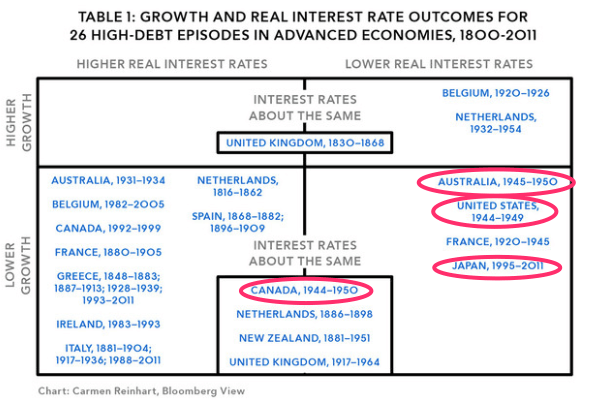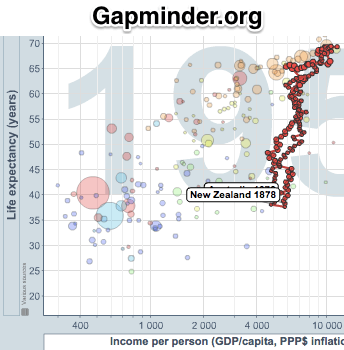How Much Should We Fear the Debt When Interest Rates Are Low?: Tuesday Focus

Over at Bloomberg News, the smart and very industrious Carmen Reinhart lays out why she fears the debt–thinks that expansionary fiscal policy to rebalance an economy is unwise even when monetary policy is hobbled by the zero lower bound on interest rates and even when long-term interest rates remain low:
Carmen Reinhart: Of Debt, Growth, Interest Rates and History:
Vincent Reinhart, Kenneth Rogoff and I… examined 26 high-debt episodes between 1800 and 2011, looking both at growth rates and at levels of real interest rates. We found that in 23 of the 26 high-debt cases, growth was low as compared with the relevant country’s performance in periods when debt was less. Table 1… sets out this result. You’ll notice it makes clear that the U.K.’s high-debt episode of 1830-1868 is one of the three exceptions…
This gives me an excuse to once again–but for the first time in this space–explain why I cannot follow her to this conclusion.
First, note that I have drawn in red pen all over the Reinhart-Reinhart-Rogoff Table 1. I have scribbled because the fact that growth was slow in Australia, Canada, and the United States as they demobilized from World War II is not a consequence of the fact that World War II left them with high debt-to-GDP ratios. Those data points deserve asterisks. Similarly, Japan’s transition from fast growth before 1990 to slow growth afterwards was not a consequence of high debt. That point deserves an asterisk as well.
So what we are left with are three cases in which (a) interest rates remained relatively low or fell and growth accelerated–the UK 1830-1868, Belgium 1920-1926, and the Netherlands 1932-1954–and three cases in which interest rates remained relatively low or fell and growth decelerated–France 1920-1945, New Zealand 1881-1951, Netherlands 1886-1898, and the United Kingdom 1917-1964.
And if I were feeling grinchy, I would point out that high-debt New Zealand’s growth tracks non-high-debt Australia’s growth exactly from 1881-1951:

And I would demand that that datapoint be asterisked too, leaving us 3-to-3.
Thus the claim fails that historic experience tells us that even if interest rates remain low it is dangerous for growth to undertake debt accumulation of the magnitude we have seen in the North Atlantic since 2007 (or are contemplating when we contemplate expansionary fiscal policy as a way of boosting employment and getting economies moving again).
The claim that such policies are dangerous for long-run growth rests, rather, on the belief that (a) our debt is about to trigger a transition to a period of destructively high interest rates, or (b) we dare not risk the possibility that our debt might trigger a transition to a period of destructively high interest rates. And assessing those arguments requires that we move away from history into theory, for history does not tell us a great deal about the conditions under which countries like the United States today that have the exorbitant privilege of providing safe asset reserves to the global financial system see their interest rates spike.
More on that anon. But for this Monday I just want you to focus on the Paul Krugman chart showing how Britain’s high nineteenth-century debt level was perfectly compatible with the then-unprecedented growth acceleration that was the British Industrial Revolution, for that was the impetus for Carmen’s Bloomberg column:

Paul Krugman: Three Centuries of Debt and Interest Rates – NYTimes.com:
Aha–somehow I didn’t know this existed. The Bank of England has produced some very, very long-term series; spreadsheet can be downloaded here. Here’s debt and interest rates… the blue line is the ratio of public debt to GDP… the red line is the yield on long-term government debt, measured on the left. You might think that these data, and the relationship they show–or, actually, don’t show–should have some impact on our current debate, especially given the tendency of many players to reject modeling and appeal to what they claim are the lessons of history.
Or are they claiming that this time is different?
And, yes, for those of you following at home without a program, this last line from Paul is a… subtweet… subblog… reference to Carmen Reinhart and Ken Rogoff (and by association Vince Reinhart)–remember that the title of the excellent 2008 Reinhart-Rogoff book about financial crises and their impacts in historical perspective is This Time Is Different: Eight Centuries of Financial Folly
706 words…

